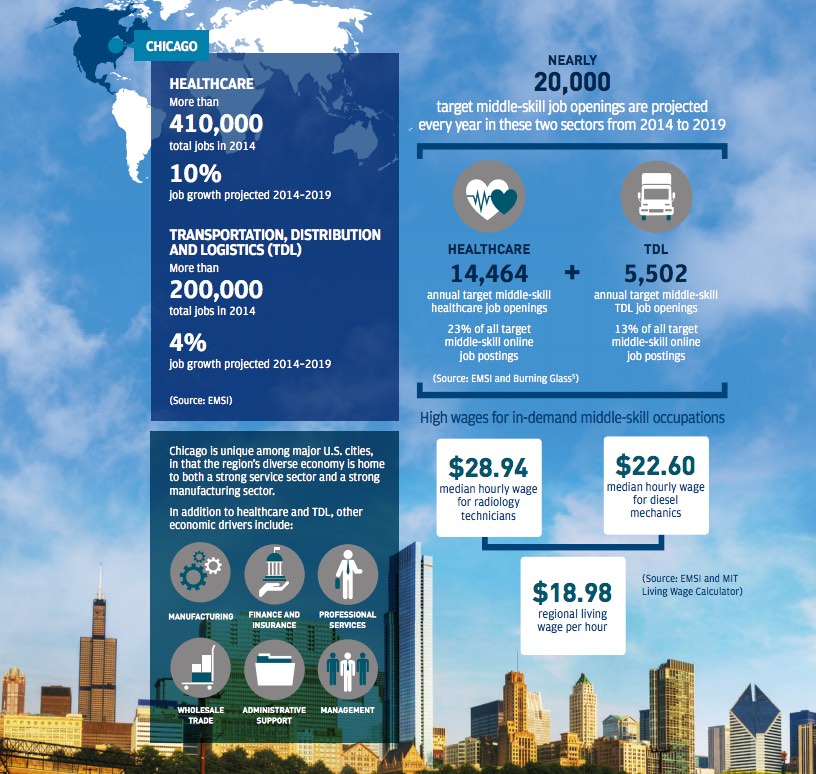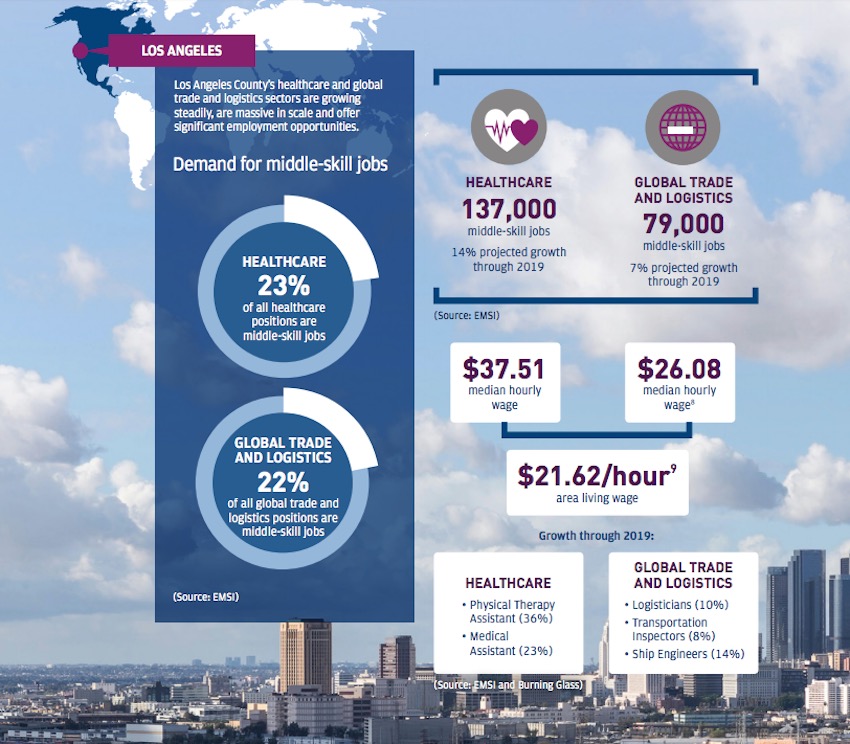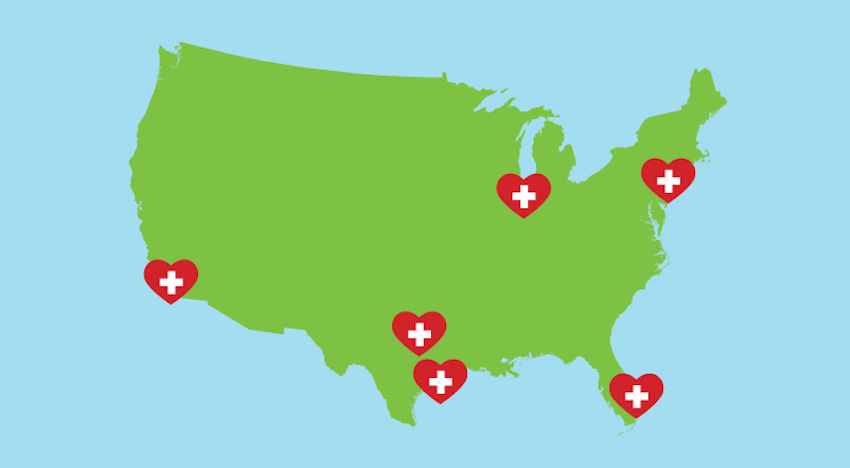Find out where to move if you’re looking for a health-care job.
Health care is the largest private sector job industry in the U.S., and, according to the Bureau of Labor Statistics, it’s expected to be among the fastest-growing industries in the years ahead, adding 4 million jobs between 2012 and 2022.
“If you look at our aging demographic, we have 10,000 people turn 65 every single day. Pair that with the Affordable Care Act, which gives health care to millions of more Americans, there’s just so much demand on that system, we can’t supply workers fast enough,” says Eric Gilpin, president of vertical sales at CareerBuilder.
While cities like Rochester, Minn.; Las Vegas, Nev.; and Rio Grande City, Texas, have the highest share of health-care jobs, according to data research from CareerBuilder and Economic Modeling Specialists International, Gilpin says people looking for work in the industry would be wise to consider cities where the demand for workers outweighs the supply.
From our partners:
“Massachusetts has the largest share of jobs, but it also has the largest supply of health-care workers,” Gilpin says. “That makes it more competitive. If you look at markets like Dallas-Fort Worth, and you look at health-care job postings between January and October, there were 23,000 jobs advertised but only 13,000 were hired. If you think about it, there’s a mismatch. If I’m a health-care worker and looking to potentially relocate or enter that sector, I’d want to know where the odds are a little more in my favor, where there’s more demand than supply.”
Using CareerBuilder and EMSI data, Livability.com looked at five of the metropolitan areas with the greatest demand for health-care workers, and one area projected to have high demand by 2020.
1. Dallas-Fort Worth
Three of the five fastest-growing cities in the U.S. are in Texas, and that’s no wonder; with a low unemployment rate and affordable real estate, it’s a great state for people and companies to settle down. In Dallas-Fort Worth, where, according to the Dallas Regional Chamber, health care comprises 15 percent of the regional economy, only one out of every seven available health-care jobs is filled, and the demand is expected to increase as the population continues to age. The industry’s growth is also driven in large part by a more than $6 billion health-care building boom, which, according to the Dallas Morning News, comprises “hospital, outpatient clinic and other health care-related construction and renovation recently completed, under way or planned” by “public, private and not-for-profit health organizations.”
2. Chicago

The health-care industry is Chicago’s biggest employer, but as long as only one out of every six available jobs is filled, it could still use more workers. According to JPMorgan Chase’s Chicago Skills Gap Report, middle-skill workers – those who’ve graduated from high school but haven’t yet completed a bachelor’s degree – inpatient care, administration and health information are in demand, and bilingual workers are particularly valuable. Personal-care aides, occupational therapy assistants and physical therapists are also much-needed, according to Crain’s Chicago Business.
3. New York City

The New York City area has the highest demand for health-care workers in the country, and that’s expected to remain the case at least through 2020. According to JPMorgan Chase’s New York City Skills Gap Report, there are 35 middle-skill health-care occupations with average earnings of $25 an hour in the region, and jobs in those areas tend to go unfilled for over a month after they’ve been posted. Occupational and physical therapy jobs are wide open, the report notes, as are high-wage jobs for radiology and MRI technicians.
4. Houston
Houston is widely known as a health-care town, and with organizations like Memorial Hermann Hospital and Methodist Hospital participating in a multi-billion dollar health-care construction surge in the city and its suburbs, its reputation in the industry is growing. The Texas Medical Center, which CBS notes is “larger than some cities’ downtown economic centers,” is the area’s biggest employer, and it needs workers at all levels. “There are thousands of unfilled jobs posted every day in health care – just in the Medical Center alone,” Kirk White, director of Coleman College’s Center for Healthcare Professionals at Houston Community College, told the Houston Chronicle. Currently, CareerBuilder and EMSI report only one in eight posted jobs are filled, and in 2020, it will still have the fourth-highest demand for workers.
5. Miami
According to the Florida Department of Health, the population of licensed health-care practitioners in the Sunshine State has increased 15.9 percent since 2010 while the resident population has increased only 5.5 percent. That’s created a great need for health-care workers. Registered nurses are the most in-demand laborers in Florida, where 7,100 jobs open up annually, and those hired make an average hourly wage of $30.28. Miami-Dade County, according to the Miami Herald, has more residents over 60 years old than anywhere else in the state, and their numbers are expected to continue driving demand for health care. Today, in the Miami area, only one out of every seven posted health-care jobs are filled.
6. Los Angeles

Los Angeles’ population is aging quickly. Between 2014 and 2019, the working-age population is projected to grow 2.8 percent, while the population of adults 65 and older is projected to grow 19.2 percent. That adds up to a large demand for health care, which, according to JPMorgan Chase’s Los Angeles Skills Gap Report, is already the largest and fastest-growing sector in Los Angeles County. For every six jobs posted, only one is filled, and if CareerBuilder and EMSI data projections hold up, the area will have the second-greatest demand for workers in the country in 2020. Today, 23 percent of health-care positions in L.A. are middle-skill jobs, and opportunities for such positions – like physical therapy assistants and medical assistants – are projected to grow 36 percent and 23 percent through 2019, respectively. The industry overall is expected to grow 14 percent through 2019.
This feature originally appeared in Livability.
















